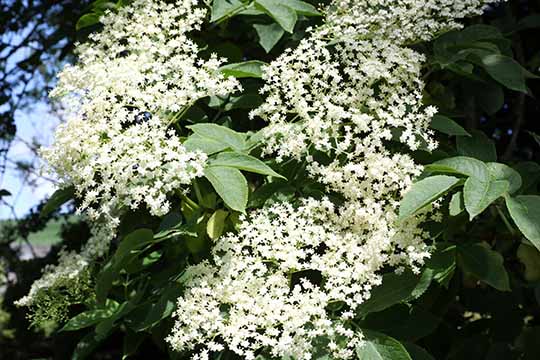Down News contributor Helen Hastings interviews experienced forager Alison McGrenaghan about the uses of Elder Flower, a common tree in local woodlands.
Helen: Well, here it is folks, the big one! The highlight of our summer is upon us. The celebration of the summer solstice! And Elderflowers!
No, I’m not talking about the annual garden party at Stormont but the less wild event known to some as the summer solstice or ‘Midsummer’. It is at this time of year the police forces around the country take a special interest in the local standing stones in the ongoing hunt for cavorting hippies who have had one too many in a mad attempt to get back to their youths.
Last year I was in Denmark where they celebrated the solstice in a pre-Covid world. The Danes embellish the event with copious amounts of alcohol, not good for a latter day Druid’s hangover. The solstice celebration is an ancient tradition marked out to honour the sun, and to thank the mother Goddess for the fruits of summer she has blessed us with.

I have the great pleasure once again of speaking to our local foraging expert Alison McGrenaghan about the benefits of wild food foraging around that magical time of the summer solstice. We’re focusing in this article, on the ‘poster girl’ of midsummer blooms, the Elderflower.
Helen: Hi Alison. So this really is the ‘big’ time of year for a lot of foragers not only because of elderflower, but from a spiritual point of view as well. There really is such a rush of energy as we approach the solstice, for you personally, why does the solstice pack so much punch?
Alison: Well it’s the zenith of the year, when the sun, quite literally stands still for three days, on it’s journey across the horizon. For those of us who live in the North of Europe, both the solstices are such tangible energetic events. There is also such a strong ancestral link for us all, as our ancient ancestors have celebrated this time of year for millenia. So when we approach both the summer and the winter solstices, it is as though we have rolled into an energetic groove in the fabric of the universe.
This is a groove created by the year-on-year footfall of human celebration, in much the same way that our footfall wears a groove in ancient stone steps where we have trodden for centuries, and the thing with grooves is that once you find yourself in one, you can’t help but be drawn into the pattern that has already been created.
The plants feel the expanse of energy too, everything is bouncing with life and vigour. This year we have had such fine weather from early in the spring and now at the height of its power, the sun just seems to be radiating back out of the hedgerows.
Helen: Elderflower is so aesthetically beautiful and also smells amazing. Can you give some examples of your favourite uses ?
Alison: The sky really is the limit with the elder tree. Back in the day it was known to country folk as “nature’s medicine chest,” as pretty much every part of the tree could be used for something.
As we are talking about elderflowers today, I will stick to floral remedies and recipes only. I love Elderflower Champagne, in fact I have a large vat of it brewing in my kitchen at the moment. Celebrity chef Hugh Fernly-Wittingstall does a good recipe if anyone fancies having a go at this one. Also elderflower fritters are scrumptious and can be served with homemade elderflower and gooseberry ice cream, although they also go well with lemon ice-cream. Elderflower cordial is delicious and refreshing too.
Our grandmothers would all have been familiar with elderflowers as a beauty treatment. It was particularly popular in the past for removing freckles, but although I am olive skinned myself, as the mother of extremely freckled children I am a supporter of celebrating the freckles!!
In general it had a reputation for lightening the skin, at a point in history when fair skin tones were the height of fashion. Nowadays, it is probably more typically used as one of the herbs that can soothe sunburn. It has a mildly astringent effect and is a soft stimulant. An infusion of elderflowers can be used for softening cleansers, toners and conditioners for hands, face and body, it is particularly good for more mature skin (and the less said about why I am familiar with the last point, the better!).

Recipe To Make Elderflower Water.
- 100g elderflower, divided into two bunches
- 500mls water
- Method: Put the first bunch of petals into a pan and cover with the water. Bring to the boil, then simmer very gently for an hour.
- Strain and put the remaining petals into the pan, covering them with the strained flower water.
- Again, bring them to the boil, and then simmer gently for an hour.
- Leave to cool before straining first through muslin.
- If plant material remains in the solution, strain again through doubled muslin. Store in sterilized bottles and for long-term preservation, you can freeze them.
Helen: There are other flowers at this time of year that look similar to Elderflower, so that poses a real danger in itself. Can you give some advice as to how to pick Elderflower safely?
Alison: Don’t just look at the flower heads. There are a number of white frilly flowers out there and not all of them are good for you.
Elderflower will have leaves that are green in colour, with serrated edges and commonly arranged in clusters of five. They will be growing from large bushes or small trees – NOT straight from the ground. They will be creamy white in colour and they will have a distinctive heady perfume to them, which once smelled, will not be easily forgotten.
It can easily be mixed up with Pyracantha, which, as far as I am aware is not poisonous and cowbane (aka water hemlock) which most definitely is poisonous. So if you are not sure, don’t pick it.
Helen: Ok, let’s get witchy!!! Are there any spiritual associations with elderflower, any medicinal qualities?
Alison: There are so very many ancient magical associations with this plant and it has both beneficial aspects as well as more negative ones, depending on how it is used.
The long and the short of it seems to be that as long as you keep it out of the house, all will be well. Out in the yard it will bring you powerful protection and will work to deflect hostile magic, fastened to doors or windows (on the outside!) it keeps malevolent fairies at bay and used in barns it will afford the same kind of protection, for humans and cattle alike.
With elderflower gathered on Beltane eve being the most potent. However, should you be fool enough to bring the elderflower indoors for decoration, the tree becomes angry and vengeful! For this reason I always recommend asking the tree for its fruit and flowers before taking them. Explain what you are going to make and thank the tree after.
There are varying reports of the benefits, or harm of sleeping beneath an elder tree. It can according to different sources either induce madness or result in prophetic dreams – only you can decide if you want to take the risk!

Medicinally and as touched on earlier in this article, there are endless medicinal properties associated with this plant. Much like its autumn counterpart, elderberry, it is used against colds and flu and upper respiratory problems. It is also a great soothing wash for skin and eyes. There is some thought that it might work somewhat like insulin in balancing blood sugars. There are many more cures it can be used in, but sadly I don’t think we have the space to go into all of them here.
If you were to create a feast using only ingredients that could be foraged at this time of year, what would your banqueting table look like?
Alison: Wow! What a great question. It would consist of wild fish and shellfish (seafood is my absolute favourite) and combine it with some edible seaweeds, fresh leaves, such as young Hawthorne, dead nettle and dandelion for salads and edible flowers such as elder, Hawthorne and wild rose.
My menu would be:
Starters
Salad of wild young green leaves and edible flower in an orange and rose hip dressing.
Alexanders soup with nettle and mozarella bread.
Potted Shrimps with sorrel sauce.
Main courses
Baked ling with samphire, served with a side of new potato with lemon and sea lettuce.
Mussels with cream and sea beet.
Wild green risotto with garlic and mushrooms
Desserts
Elderflower fritters with elderflower and wild gooseberry ice-cream.
Wild rose petal and coconut cake.
Rose petal milkshake and edible flower shortbread.
Helen: The recent coronavirus crisis has forced us all to stop and slow down whether we like it or not and our attitudes to food and living have become much more meditated and mindful. Do you think our new connections with the more primal part of our natures will last?
Alison: For some it has always been a way of life and will continue to be so, for others it will be a passing interest that is soon forgotten. But for some people, they will have a little wade in the water and discover it really is for them. And as long as it is done respectfully and without harm to others and nature, each to their own say I.
***
























